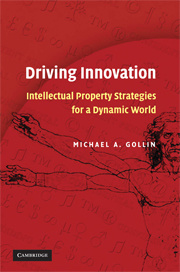Description
Driving Innovation
Intellectual Property Strategies for a Dynamic World
Author: Gollin Michael A.
This book shows how intellectual property can expand innovation globally, if it is managed strategically.
Language: English
Approximative price 71.14 €
Subject to availability at the publisher.
Add to cart
Driving innovation: intellectual property strategies for a dynamic world
Publication date: 02-2008
432 p. · 16x24.1 cm · Hardback
Publication date: 02-2008
432 p. · 16x24.1 cm · Hardback
Approximative price 36.43 €
Subject to availability at the publisher.
Add to cart
Driving innovation: intellectual property strategies for a dynamic world (Paper)
Publication date: 02-2008
432 p. · 15.4x23.4 cm · Paperback
Publication date: 02-2008
432 p. · 15.4x23.4 cm · Paperback
Description
/li>Contents
/li>Biography
/li>
How does IP balance the exclusive rights of innovators with public demand for access to their innovations? How can organizations manage IP strategically to meet their goals? How do IP strategies play out on the global stage? Driving Innovation reveals the dynamics of intellectual property (IP) as it drives the innovation cycle and shapes global society. The book presents fundamental IP concepts and practical legal and business strategies that apply to all innovation communities, including industry, non-profit institutions, and developing countries. Further, it draws on the author's broad experience, news headlines, and precedent-setting lawsuits relating to patents, trademarks, copyright, and trade secrets - from biotechnology to the open source movement. General readers and students will welcome the lively overview of this complex topic, while executives and practitioners can gain new insights and valuable approaches for putting ideas to work and navigating within or changing the global IP system to expand innovation.
Preface; Introduction: the invisible infrastructure of innovation; Part I. Intellectual Property Dynamics in Society: 1. The innovation cycle; 2. The rise of the intellectual property system; 3. Balancing the tension between exclusive rights and the accessible domain; Part II. Basics of Managing Intellectual Property in Organisations: 4. The innovation forest: intellectual property rights and how they grow; 5. The ABCDs of intellectual property: flow and infringement of IP rights; 6. The global diversity of innovation communities; 7. The role of the innovation chief; Part III. Steps to Strategic Management of Intellectual Property: 8. Becoming strategic; 9. Strategy tools: policies and practices for managing IP; 10. A menu of strategy options; 11. Evaluating internal resources and the external environment; 12. Placing a financial value on IP assets; 13. Accessing innovations of others; 14. Protecting and enforcing IP rights; 15. Transferring IP rights; Part IV. Strategies on a Global Stage: 16. Specific IP strategies for different communities; 17. Global challenges; 18. Intellectual property, innovation, and freedom; Acknowledgements; Abbreviations; Further reading; Appendices (A: TRIPS excerpts; B: Non-policy; C: Audit questionnaire; D: research resources).
Michael A. Gollin is a partner and patent attorney at Venable LLP. He is also an adjunct professor at Georgetown University's McDonough School of Business, where he teaches strategic management of intellectual property. Mr Gollin obtained his bachelor's degree in biochemical sciences from Princeton University, and a master's degree in zoology and molecular biology from the University of Zurich, where he was a Swiss National Foundation Fellow. He received his law degree from Boston University School of Law in 1984, where he was a Tauro Scholar and Liacos Scholar and received the Faculty Award. He worked in law firms in Boston and New York before moving to Maryland and building an international intellectual property law practice in Washington, DC. In addition to numerous appointed and elected positions, in 2002, Mr. Gollin launched Public Interest Intellectual Property Advisors (PIIPA), a pro bono service for developing country clients. Mr. Gollin has co-authored two books - Biodiversity Prospecting and Innovations in Ground Water and Soil Cleanup: From Concept to Commercialization - and has published and presented about 100 law review articles, papers, and speeches. He has provided commentary on intellectual property issues to news media such as National Public Radio, Time Magazine, Guardian Weekly, Legal Times, Fox News Channel, and Bloomberg News.
© 2024 LAVOISIER S.A.S.




